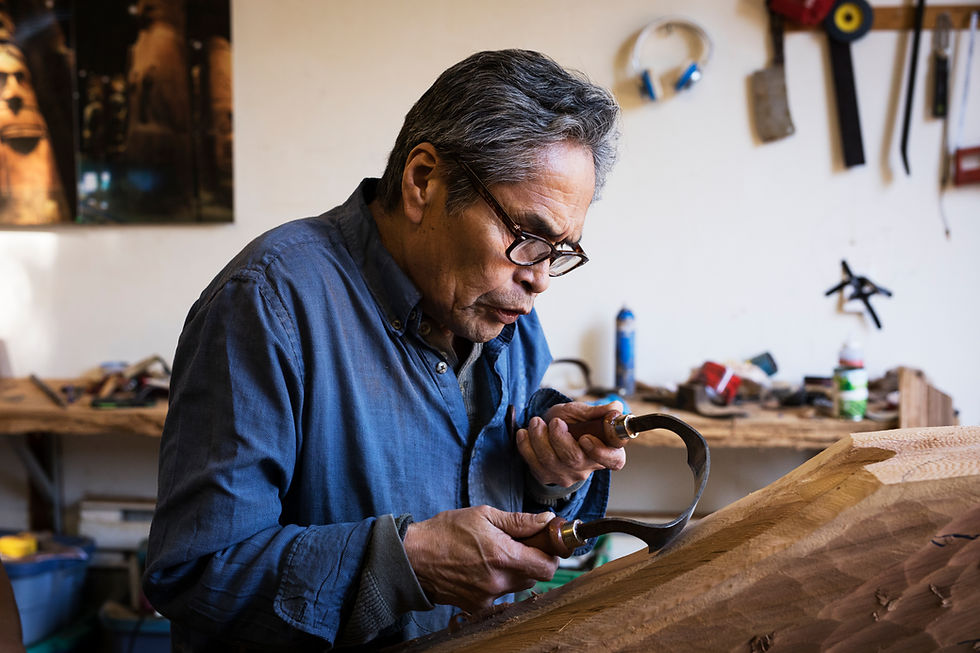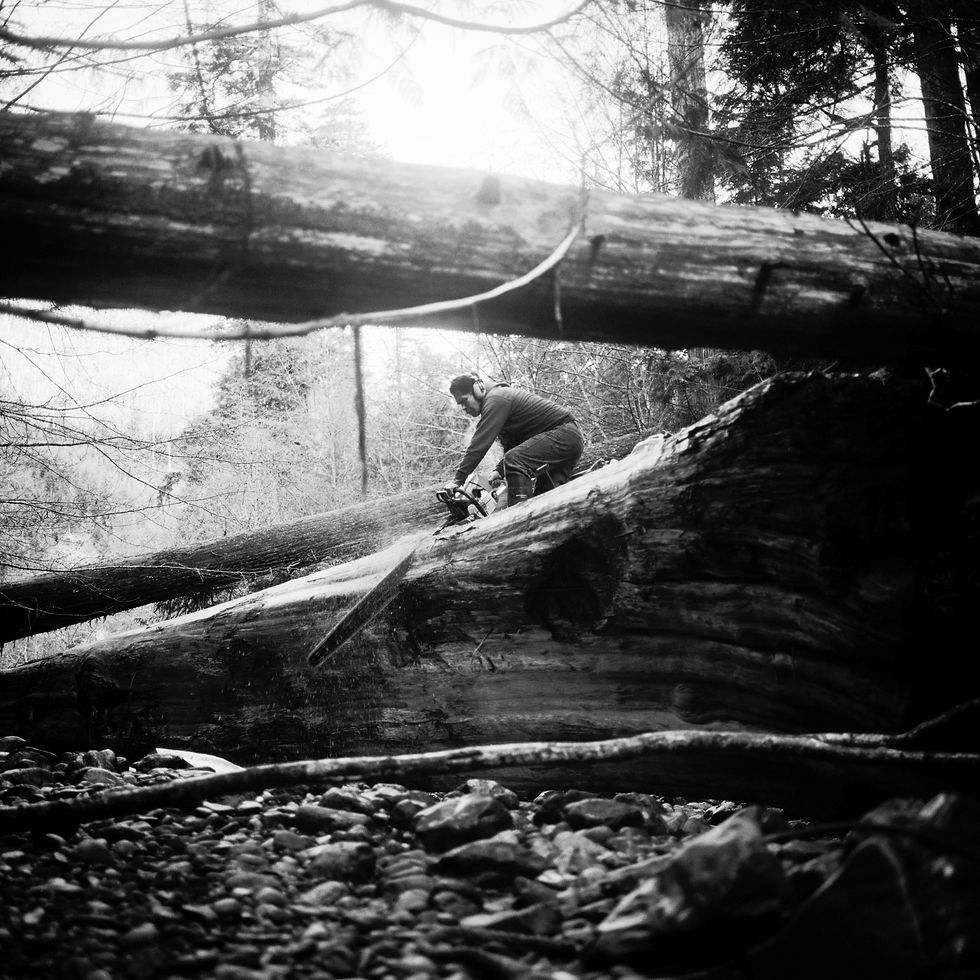by Melissa Renwick

LOW HANGING CLOUDS ENGULFED MEARES ISLAND as the wind howled, commanding the heavy branches on 1,000-year-old red cedar trees to hurl back and forth. Oblivious to the brisk, winter air that cut to the bone, Joe Martin and his brother, Carl, were hunched over a fallen red cedar focused on their task at hand. The pair swiftly worked alongside their father, Robert, to hollow out the log making way for a traditional dugout canoe. It's a practice they have dedicated their lives to and are now sharing with the next generation of members from their community.
For three months in 1984, the Tla-o-qui-aht men embraced the Northwest Coast’s wicked winter from a small, wooden shack they built on Meares, an island in Clayoquot Sound that stands as a backdrop for Tofino. It was the beginning of the War in the Woods, a series of anti-logging protests that drew around 12,000 people to prevent forestry company Macmillan Bloedel from clear-cutting in Clayoquot Sound. The blockade became one of the largest acts of civil disobedience in Canadian history. They were there to give back to the trees that Joe said had always provided for them. “The main part of our culture was canoe carving,” he added.
Nuu-chah-nulth nations along Vancouver Island’s west coast have long relied on old-growth forests to sustain their lifestyles and culture. They require the strength and size of ancient red cedar trees to carve dugout canoes and totem poles. Before motorboats, Joe and Carl depended on canoes to travel between village sites, to fish, hunt, and gather wood, along with other resources for Tla-o-qui-aht members. Canoes allowed First Nations communities to be self-sufficient and use the cycles of nature as their guide.
Protocols were put in place to protect forest ecosystems, said Joe of his father’s teachings. Trees were only harvested in the fall and winter so as not to disturb active wildlife in the spring and summer. The cooler seasons also meant avoiding the sap that runs through the trees in warmer months, increasing the probability of rot. “People don’t pay much attention to those protocols anymore,” Joe said. “Not much respect is given to [the forest].”

Unsustainable logging practices in British Columbia have made it increasingly difficult for Joe and Carl to find trees large enough to carve canoes from. “Forest companies have targeted all of the best areas we have for red cedar,” Joe said. “It’s very concerning because we won’t have any more of it left and that’s a detriment to our future generations.”
Only an approximated eight per cent of the original old-growth forests remain in the province, according to an independent scientific report titled, BC’s Old Growth Forest: A Last Stand for Biodiversity. “These ecosystems are effectively the white rhino of old growth forests,” reads the 2020 report. “They are almost extinct and will not recover from logging.” Fearing this fate, Joe, Carl, and their late-father Robert Martin Sr. joined protestors on Meares Island by doing what they had always done–caretaking the forest.
During those three months at the blockade, they spent their time carving three 16-foot canoes from a single fallen log. One of those canoes can be found on display at the Roy Henry Vickers Gallery in Tofino. “It felt really good to be there,” said Carl. “Canoes are a part of our history, and it was our point to prove that we were still [using] them.”
Not only did that moment in time define the future of Meares Island and its old-growth forests–which is protected as a Tla-o-qui-aht Tribal Park and largely remains intact–it also carved the course of Joe’s future. Much like his father and great-grandfather upheld their duties to pass down their ancestral teachings, Joe said it’s his “responsibility” to do the same. Since those early days on Meares Island, Joe estimates that he’s carved upwards of 70 canoes. In truth, he said, “I’ve lost count.”
Often requested to travel to neighbouring nations to build canoes for their communities, Joe has led projects in Powell River, Comox, Gold River, Campbell River and Ucluelet, among others.
Plus, Joe released a book in 2022 with Alan Hoover, the former curator of the Royal British Columbia Museum in Victoria. Entitled Making a Chaputs: The Teachings and Responsibilities of a Canoe Maker, it details step-by-step the canoe-making process. Paired with personal histories and teachings from his father, the book is a visual record meant to serve generations to come.
Showing no sign of slowing down, the 70-year-old often has two or three canoe projects on the go at any given time. More recently, Joe and Carl partnered with Tla-o-qui-aht First Nation on building a preventative youth and family program. As part of the program, the master carvers will mentor three apprentices over 70 days as they carve two canoes from start to finish.

The apprentices will begin in the forest, learning how to harvest and hollow out the tree. They will then move it to the Tla-o-qui-aht First Nation village of Ty-Histanis, where they can involve more youth and community members. Once the canoes are carved, Tla-o-qui-aht First Nation Capacity Building Coordinator Norine Messer said they will use them to find traditional foods and plant medicines for harvesting, bringing youth together with their homelands. “Canoes are essential to community life and connection with the water,” said Messer. “Tla-o-qui-aht is working on becoming trauma-informed and building resilience in our community through healing from the intergenerational trauma of residential schools and colonization.”
The federal government introduced the Indian Act in 1876, which aimed to eliminate Indigenous culture by attempting to homogenize First Nations into a Euro-Canadian society. The “Potlatch Law,” which was later introduced as an amendment to the act, rendered it illegal for First Nations to practice art, dance, or cultural ceremonies. Because of this, Messer said “the transmission of that knowledge was lost.”
Fortunately, Joe said, his father didn’t give him a choice of whether he wanted to go hunt, fish, or carve a canoe while he was growing up. That time on the land with his father allowed him to retain Nuu-chah-nulth oral history, which has been traditionally taught through repetition. This is why his friends say you’ll often hear Joe tell the same story twice. “I’ve been around Joe when he’s teaching young people about carving a canoe,” said Messer. “There’s a lot of teachings around self-esteem, respect for the environment, for the trees and for the canoe itself.”
Tsimka, Joe’s youngest daughter, is one of the three apprentices who will be learning to carve a canoe through the Tla-o-qui-aht program. “This is something my dad has done so many times,” she said. “Getting to know him in a really different way through being a part of the work and seeing how he teaches will be grounding in home-community and culture.”
Left to right: Carl Martin poses for a photo with a canoe he is carving in Naa'Waya'Sum Gardens in Tofino, on July 19, 2023; Master carver and Tla-o-qui-aht elder Joe Martin poses for a portrait on Chesterman Beach, in Tofino, on August 11, 2021. Photos: Melissa Renwick
The unbroken chain of learning from her father, who learned from his father, who was taught by his father, provides a “link to the strength of our ancestors and to the health of these lands,” she said. An avid Nuu-chah-nulth language learner and teacher, Tsimka said she hopes to integrate language resources into the project. Much like canoe carvers, she said there is only a handful of fluent elders left. “Sometimes it feels like a heavy responsibility because it's at such a critical point,” she said of the Nuu-chah-nulth language, and now, the process of carving a dugout canoe. “The opportunity to actually witness it fully and learn it more fully feels important,” Tsimka added.
Many youths and carvers from across the province have helped Joe with portions of the process, but Joe said only three people have carved a canoe with him from beginning to end. It’s a detail he chooses not to focus on. “All of the people that have learned different parts of it will come together and figure the rest out for themselves,” he said. “I’m not going to be around forever. I wish I was.”
For now, he can rest more easily knowing that his daughter will be there to witness his teachings so they can live on the way his father intended.
_____
Melissa Renwick is a documentary photographer and writer who has found home on the Canadian West Coast, in Tofino. She is interested in documenting the complicated interrelationship between the coastal landscape and those who inhabit it. Through her intimate style of portraiture and long-term storytelling, she aims to capture the different ways people live in remote regions of the country.
This article appears in the Spring/Summer 2024 issue of Ornamentum magazine. To purchase the issue or subscribe, head to our store.





Comments